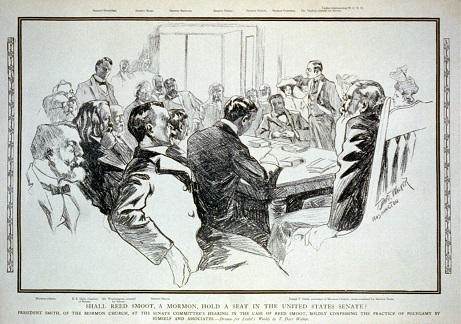
Word of the Day: Polygamy
Paul Schleifer
In common parlance, polygamy refers to being married to multiple spouses at the same time, and when people think of the word, they normally think of one man married to several women (if it were one married to two women, it would be bigamy). The opposite of it would be monogamy, which in common parlance means being married to only one person at a time, though the third definition of monogamy is “the practice of marrying only once during life” (http://www.dictionary.com/browse/monogamy).
Etymologists seem not entirely sure of the origin of the term. Poly- comes from Greek and, usually, means many. The base –gamy has something to do with marriage: from Greek gamete “a wife,” gametes “a husband,” from gamein “to take to wife, to marry,” from PIE root *gem(e)- “to marry” (https://www.etymonline.com/word/gamete?ref=etymonline_crossreference). But in this sense it might mean something like “often married” without reference to whether the multiple spouses overlapped in time.
Most of us are familiar with the term polygamy, but there are other, more precise terms to describe marriages of more than two people. Polyandry is a marriage involving one woman and two or more men (andry is from Greek aner [genitive Andros] “a man, a male”). Polygyny describes a marriage involving one man and more than one woman (gyny from Greek gyne “woman, wife”). Polyamory, according to www.dictionary.com, is “the practice or condition of participating simultaneously in more than one serious romantic or sexual relationship with the knowledge and consent of all partners,” so one might imagine its being used to describe a marriage of two or more men and two or more women. But polygamy is the term that is used to describe any marriage involving more than two people.
On this date in 1882, Congress passed the Edmunds Anti-Polygamy Act (also called the Anti-Plural Marriage Act), which was signed the next day by President Chester A. Arthur. Part of the purpose of the Edmuncs Act was to plug some holes left by the Morrill Anti-Bigamy Act, signed into law by Abraham Lincoln on July 8, 1862. The Edmunds Act made polygamy a felony, but it also made bigamous or polygamous cohabitation a misdemeanor crime because it was sometimes hard to prove that the participants in a polygamous married were “married.”
The Edmunds Act, as enforced, made it illegal for polygamists to vote, hold office, or serve on juries. This law applied not only to people who practiced polygamy but even to those who professed a belief in polygamy, which was part of Mormon doctrine. The federal government took over the oversight of the election process in Utah (home of the Mormon faith), with the president appointing a Utah Commission which first vacated the previous election in Utah and provided certification to those citizens who openly professed a lack of belief in the doctrine of polygamy.
The Mormon church (officially The Church of Jesus Christ of Latter Day Saints) at first fought against the Act, even going to the Supreme Court, but the Court upheld the Constitutionality of the Edmunds Act (though I do not see how, given that there is a first amendment). Then the Mormon church decided to undo its doctrine on polygamy, which made the church acceptable to the federal government; that concession also led to Utah’s becoming a state in 1896.
In 1903, the Utah legislature elected Reed Smoot to be one of their two senators. When he arrived in Washington to fill his post, he was seated by the U.S. Senate, but in 1904 the Senate began hearings into Smoot’s eligibility to serve as a senator, hearings that lasted until 1907.
The worst part of the story is that Reed Smoot is not known for this story about polygamy but rather for his cosponsoring the Smoot-Hawley Tariff Act of 1930, one of the government actions that turned an economic downturn (the Stock Market Crash of 1929) into the Great Depression.
The best part of the story is this little anecdote: “One supporter was Senator Boies Penrose of Pennsylvania. Addressing the subject of polygamy, Penrose reportedly glared at one or more of his Senate colleagues who had a reputation for philandering and said, ‘As for me, I would rather have seated beside me in this chamber a polygamist who doesn’t polyg than a monogamist who doesn’t monag’” (https://en.wikipedia.org/wiki/Reed_Smoot_hearings).
There are today in our legislators no polygamists. But I fear there are quite a few monogamists who don’t monag.
The image is a “Picture showing Joseph F. Smith being cross-examined by Senator George Frisbie Hoar. Caption: “Shall Reed Smoot, a Mormon, hold a seat in the United States Senate? President Smith, of the Mormon Church, as the Senate Committee’s hearing in the case of Reed Smoot, boldly confessing the practice of polygamy by himself and associates.” Illus. in: Frank Leslie’s Illustrated Newspaper, (1904 March 17), p. 245.” The original was a “drawing by T. Dart Walker” (https://commons.wikimedia.org/wiki/File:Shall_Reed_Smoot,_a_Mormon,_hold_a_seat_in_the_United_States_Senate_cph.3b48653.jpg).